Orange Filefish
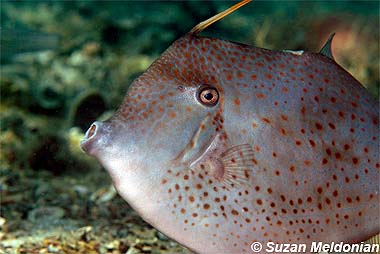
Aluterus schoepfii
Despite its name, the orange filefish displays a variety of colors and patterns from olive-gray to rich orange to soft white, and from light freckling to complex blotchy patterns. It has a tall, oval, flat body with a small mouth, narrow caudal fin, and short, soft continuous dorsal and anal fins. It prefers living in sea grass beds or other vegetation, where it grazes on algae and seagrass, but if startled, it darts to a nearby crevice and erects its one rigid dorsal spine and wedges itself into its protected space.
Order – Tetraodontiformes
Family – Monacanthidae
Genus – Aluterus
Species – schoepfii
Common Names
English language common names are orange filefish and tobaccofish. Other common names include alutera pomaranczowa (Polish), bourse (French), bourse orange (French), cabrinha (Portuguese), cachúa (Spanish), cachúa lija pintada (Spanish), cachúa naranja (Spanish), cachúa perra (Spanish), chivo (Spanish), dormilona (Spanish), drückerfisch (German), filfisk (Swedish), galhudo (Portuguese), gourounópsaro (Greek), kawahagi (Japanese), kihoshihagi (Japanese), lija anaranjada (Spanish), lija naranja (Spanish), liso (Portuguese), liza anaranjada (Spanish), mihaca (Serbian), ndor gar (Wolof), orange filfisk (Danish), peixe-gatilho (Portuguese), peixe-gatilho-liso (Portuguese), peixe-porco (Portuguese), peixe-porco-galhudo (Portuguese), pesce balestra (Italian), pez ballista (Spanish), trekkervis (Dutch), tryckarfisk (Swedish), and viilakala (Finnish).
Importance to Humans
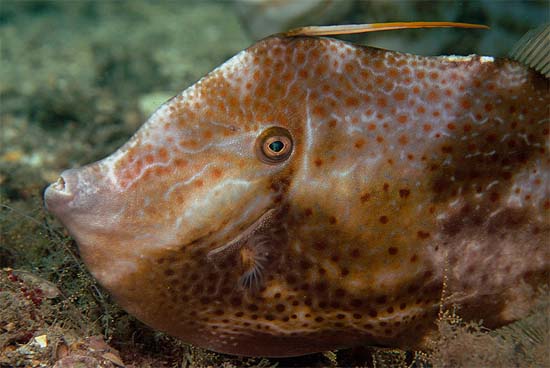
Considered a trash fish, the orange filefish is rarely consumed. If the flesh of this fish is eaten, caution should be taken as there have been reported incidences of ciguatera poisoning. This species is often seen on display in public aquariums.
Conservation
The orange filefish has not been evaluated by the World Conservation Union (IUCN) Redlist as an endangered or threatened species. The IUCN is a global union of states, governmental agencies, and non-governmental organizations in a partnership that assesses the conservation status of species.
> Check the status of the orange filefish at the IUCN website.
Geographical Distribution

The orange filefish is found in the western Atlantic Ocean from Nova Scotia (Canada) to Bermuda and the northern Gulf of Mexico and off of Brazil. In the eastern Atlantic its range is Cape Blanc and Mauritania to Angola.
Habitat
Adults, either solitary or in pairs, are typically observed over seagrass, sand, and mud bottoms to depths of 3,000 feet (900 m). They often drift with their head pointing downward among seagrasses in an attempt to camouflage from predators and prey alike. When threatened, they seek the protection of crevices. Juveniles are often associated with floating rafts of sargassum. In addition to camouflage, filefish use spines for protection from predation. When threatened, the filefish will dive quickly into a crevice in the reef, wedging itself into the shelter by erecting the dorsal spine on its head. This large spine is locked into place by the smaller spine located behind it while another spine located on the belly extends to further securely wedging the fish in the crevice.
Biology
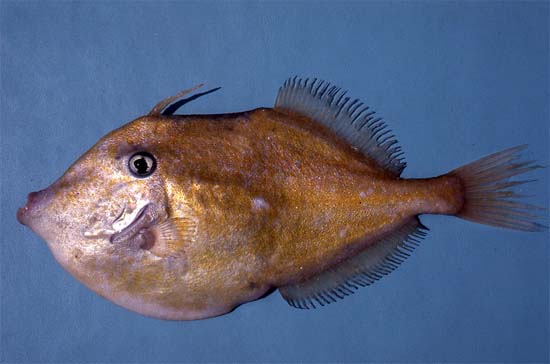
Distinctive Features
The body of the orange filefish is deeply keeled and strongly compressed. The snout is pointed and the mouth is terminal. The upper profile is straight to slightly concave in adults. The pelvic bone is prolonged but does not project externally. The eyes of filefish are set lower further down on the sides of the head along with longer gill openings than members of the genus Monacanthus. The dorsal spine, which is relatively shorter than in Monacanthus, is very thin and located at the crown of the head. The second dorsal spine is barely visible. The lower jaw projects considerably beyond the upper jaw. The soft dorsal fin originates posterior to the middle of the body and is rounded. The anal fin is similar to this dorsal fin in size, shape, and position on the body. The pectoral fins are small and rounded. The caudal fin is narrower than other filefish and triggerfish and measures more than half the body length.
Coloration
The body of the orange filefish varies from olive gray to rich orange-yellow or milky-white on the dorsal surface with mottling of darker hues of these same colors. Large irregular pale blotches may also be present. The lips are often darker in color than the body. The caudal fin is typically yellowish on adult specimens or may be dusky and edged in white. The bottom surface of the body is bluish-white in color.
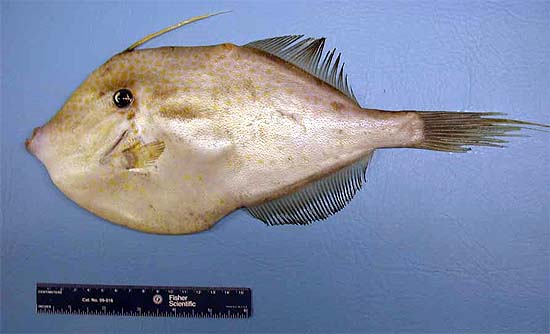
Dentition
The orange filefish has a small terminal mouth with specialized incisors on the upper and lower jaws. In the upper jaw, there are four teeth in the inner series and six in the outer series. There are only six teeth on the outer series on the lower jaw.
Size, Age, and Growth
The maximum reported length of the orange filefish is 24 inches (61.0 cm) total length (TL). This species is more commonly seen at lengths of 16 inches (40.0) cm TL.
Food Habits
This filefish feeds on a variety of marine vegetation including algae and seagrass.
Reproduction
Filefish breed in groups consisting of one male and two to five females. The females lay demersal eggs in safe areas such as a depression in the sand, then the male comes along and fertilizes them. The male or female will guard these fertilized eggs from predators and will attack any intruders that approach too closely. Juvenile filefish are pelagic, searching out floating sargassum for protection from predators such as tuna and dolphinfish.
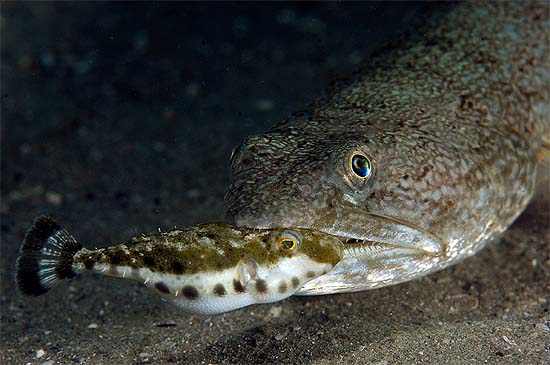
Predators
Predators of the orange filefish include fish and seabirds such as the inshore lizardfish (Synodus foetens), brown noddy (Anous stolidus), and sooty tern (Sterna fuscata).Parasites
The parasitic copepod Anchistrotos occidentalis has been documented as collected from the gills of an orange filefish.
Taxonomy
The orange filefish was originally described as Balistes schoepfii by Walbaum in 1792. This name was later changed to the currently valid scientific name of Aluterus schoepfii (Walbaum 1792). Synonyms referring to this species in past scientific literature include Alutera schoepfii Walbaum 1792, Balistes aurantiacus Mitchill 1815,Alutera aurantiacus Mitchill 1815, Aluteres cuspicauda Mitchill 1815, Balistes cuspicaudata Mitchill 1818, Alutera punctata Agassiz 1829, Aluterus punctatus Agassiz 1829, Aluterus holbroocki Hollard 1855, andAluterus cultrifrons Hollard 1855. Monacanthidae is derived from the Greek monon meaning “one” and akantha meaning “thorn”, referring to the characteristic dorsal spine found on species within this family.
Prepared by: Cathleen Bester